All About Training Delivery: Methods, Approaches and Examples

In this article, we’ll guide you through the use cases of the most common methods so you can decide which one will help you achieve certain goals in workplace training.
Over the past 20 years, technology has transformed the workplace, making us more mobile and digitalized than ever before. But with more ways to deliver training to the learners, it can be challenging to find out which method will work best.
Can a video course beat on-the-job coaching? Is it OK to replace an instructor with a computer? Are live workshops really effective, or just a pretense to have fun during work hours? These are good questions, but before you start considering the pros and cons of any specific way to get knowledge to learners, you’ll have to decide on one important thing — the type of training you’re going to have.
The Three Types of Training Program
All training programs (it doesn’t matter which delivery method they use) can be divided into three categories depending on the approach to the learning process:
- Synchronous learning
- Asynchronous learning
- Blended learning
Synchronous learning
Synchronous learning happens when a live instructor interacts with a group of learners in real time. It doesn’t matter if the group is sitting in a brick-and-mortar classroom or online; the key thing is that they are being trained simultaneously.
The most common synchronous formats are:
- On-the-job training or coaching.
- Traditional classroom training.
- Workshops.
- Live webinars.
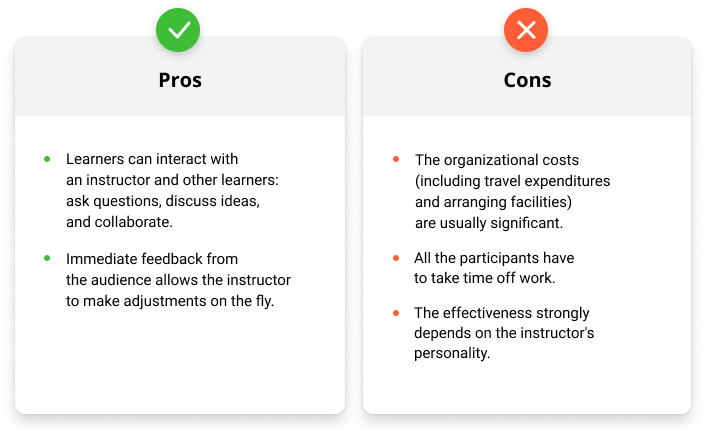
Asynchronous learning
Asynchronous learning is often called self-paced learning since it allows learners to study courses at their own speed. Most eLearning content is asynchronous, like workout videos. Just like with the videos, there’s no real-time communication between learner and instructor; in some cases, there’s no interaction at all.
The most common asynchronous formats are:
- eLearning computer or web-based programs
- Training videos
- Podcasts
- Email courses
- Wikis and blogs
- Printed workbooks
All of these may or may not also include assessment and a facilitator who provides guidance, answers questions, and collects feedback.
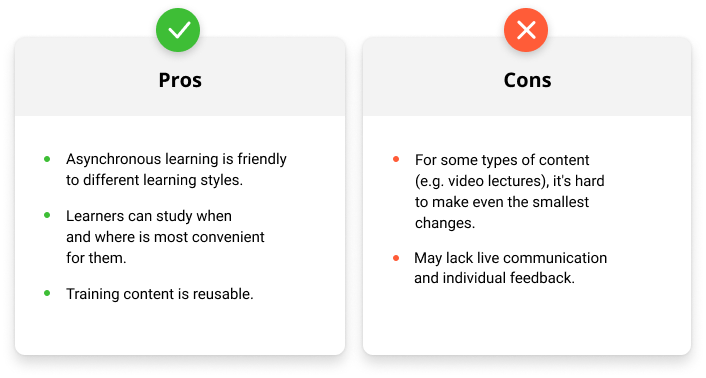
Blended learning
The two approaches — synchronous and asynchronous learning — can be combined in order to get the best of both worlds. For example, the “One Learning a Day” program by Danone includes self-paced e-courses on a virtual platform, live workshops and networking sessions, and on-the-job coaching.
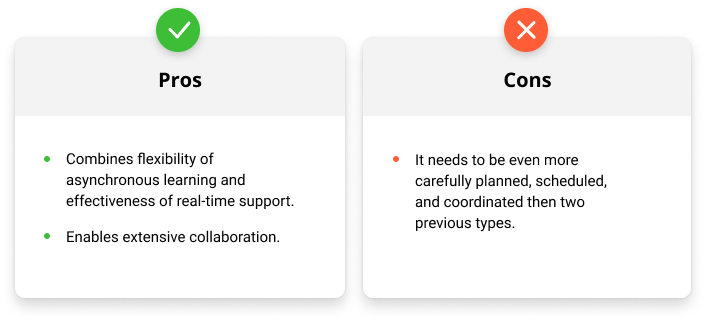
Common Training Delivery Methods
How you get your training to the learners is essential to effective learning in the workplace. Below are descriptions of the most common delivery methods and situations in which each of them works best.
Live Classroom Training
According to the 2018 State of the Industry report from the ATD, 54% of training was delivered via live face-to-face instructor-led sessions in 2017. Taking into account the rapid development of mobile technologies, virtual reality, and artificial intelligence, it may surprise you to know that more than half of training still happens in classrooms. This method, however, has a lot of benefits that can’t be beaten by technology for now.
In-person training allows you to convey practical experience and broadcast corporate culture, makes communication occur in real time, and allows information to flow in two ways.
Works best for:
- Conducting training that is tailored to the specific needs of each group.
- Building stronger relationships and improving communication within a group.
- Providing immediate feedback.
The main issue with classroom training is the lack of scalability. This includes several aspects:
- The effectiveness of this method depends directly on the professionalism and personality of an instructor.
- It’s also dependant on the size of the class — the smaller, the better (so it can be a problem if there are hundreds of employees in your company).
- It’s hard to provide learners with unique learning experiences since the pace of the group matches the pace of the majority. Sometimes it’s impossible to provide the fastest and slowest learners with individual learning paths.
- Organizing in-person training is usually expensive (especially if it happens in an off-site location) and requires careful planning so all the learners can attend.
Webinars
The webinar is the little brother of classroom training since it’s the same lectures, presentations, or workshops only conducted on the web. Webinars don’t require the physical presence of all participants in one location, so they’re a convenient and cost-effective way to reach every employee of a large company.
At a webinar, speakers can go on a webcam, demonstrate slides, or share their screens. Learners, on the other hand, have limited capabilities for interaction: they can often only use the chat section to send their questions and comments, but it’s up to the speaker how to manage them.
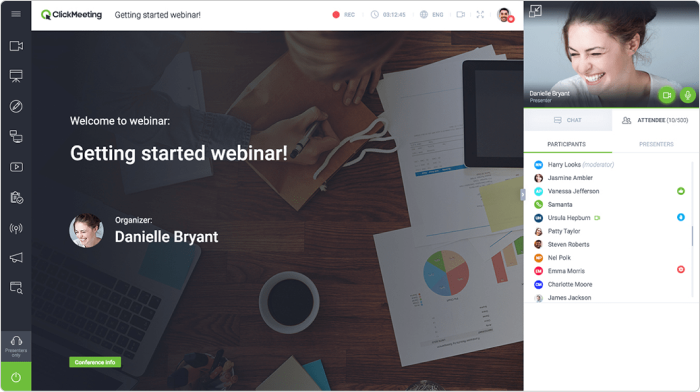
You can record a webinar once and then re-use it as part of an eLearning course.
Works best for:
- Teaching large groups
- Remote employee training
The main issue with webinars is engagement. Most webinars take at least 40–60 minutes to teach something, but it’s more challenging to keep learners’ attention than at an in-person event because they can be easily distracted. Social networks, task managers, and messengers are all just a click away, and there may be a TV or radio blaring, screaming children, or a thousand other possible distractions in the immediate vicinity.
eLearning courses
There are various things that can be labeled as an eLearning course, from a PowerPoint presentation to a serious game with VR and complex interactions. In general, eLearning often takes after live workshops: there are text and visual content on the screen which can be accompanied by an instructor voiceover. They can also include video lectures, simulations, interactive quizzes, and additional material for further reading.
The latest trends also offer you mobile learning, which includes all of the activities mentioned above, but adapted for smartphones and tablets.
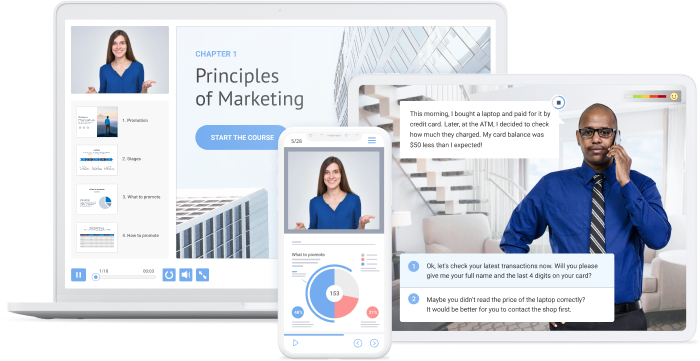
eLearning content examples
Works best for almost any training that doesn’t require immediate feedback from the instructor or live collaboration between learners. May include:
- Product training
- Compliance training
- Software training
- Onboarding
Properly designed eLearning removes unnecessary chit-chat and other time-wasters which are inevitable in live classes.
It also can be a solution for companies with many employees. eLearning eliminates travel and accommodation expenditures, so it’s cost-effective, and you can be sure that even the largest team will have the necessary training done by a certain date.
Plus, eLearning is easily combined with other training delivery methods and works perfectly for a flipped classroom model (online learning, offline application).
The main issue with eLearning courses is that they don’t work well for teambuilding and don’t motivate social interaction. Also, the development of quality eLearning content can require a significant amount of time, money, and skill.
Fortunately, there are easy-to-use authoring tools such as iSpring Suite that help you get started easily.
Study groups
Study groups are an informal and low-cost way for people to learn together. They can be conducted in person (e.g. in a conference room at the office), with the help of a virtual meeting room, or — the easiest and most popular way — in special, often private, chat groups in messengers.
Works best for providing an additional learning experience, engagement, and communication. Study groups can hardly be a standalone solution for training delivery, but it’s a good way to extend the value of self-paced eLearning programs. Learners can discuss what they are learning, help each other with difficulties, and share their ideas on how to apply what they’re studying at work.
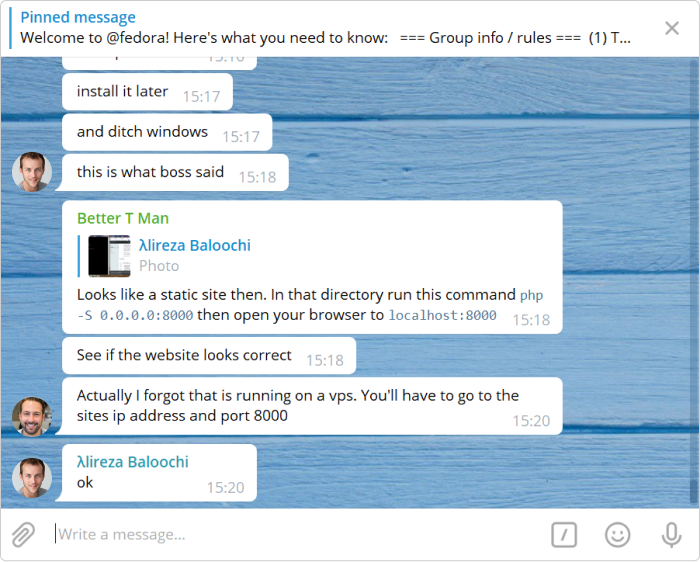
Participants of this channel in Telegram discuss issues with Fedora software.
On-the-job training
Training doesn’t always have to be in the form of a course. On-the-job training is a good example of learning by doing. In on-the-job training, there’s usually no formal instructor since experienced employees are assigned to take newbies under their guidance. Sometimes it’s called the master-apprentice model.
Newly-hired employees learn how to do something by being guided through progressively more challenging tasks until they’re ready to work on their own.

On-the-job training is perfect for mastering practical skills in a real-world environment.
Works best for:
- Onboarding programs (or at least can be an efficient part of such initiatives).
- Teaching purely practical skills.
- Meeting employer requirements for junior staff.
The main issue with on-the-job training is that its result depends on the ability of another employee to be a good mentor. Every so often, talented professionals can reach high results in their job but fail as teachers. Also, mentoring takes away a considerable amount of time from your most high-performing employees, which may lead to lower KPIs.
Also read: → Different types of employee training
How to Choose a Delivery Method
Live or virtual, synchronous or asynchronous, on-the-job or in the classroom, one-on-one or one-on-many or many-on-one, face-to-face or technology delivered—it’s all the same in terms of learning. Begin with the learner.
~ Harold D. Stolovitch and Erica J. Keeps, Telling Ain’t Training
When planning a training program, delivery is an important aspect that should be considered as one of the last steps, and that’s not a coincidence. By the time you’ve analyzed your training needs and goals and learned the target audience inside out, you should have a strong idea of how the training will reach the masses.
A limited budget and time constraints will probably cut off expensive options such as VR simulations. Flexible work hours or the remote nature of some work seem to be a good reason for eLearning; the need to teach practical trades suggests that you can’t help but adopt on-the-job training.
Here’s a list of key questions that will help you decide on the method:
- What are the training goals of the program? (The goal “to learn the art of public speaking” will definitely require a live session, while “to master Excel” is fine with an eLearning course.)
- What do you need to teach? (Does it require discussions? Real-time feedback? Hands-on practice?)
- Who are your learners? (Are they located in the same office? Can they attend live events? What will it take for them to find time in their schedule for training?)
- How many learners do you have? (What is the cost per learner for different delivery methods?)
- What’s your budget?
- What resources do you have for development? (Will you develop in-house or hire a third-party company? If in-house, what expertise does your training team have?)
- How much time do you have for creating content? (Is it a realistic plan with the budget and resources that you have?)
- When do employees need to be trained? (If the answer is “tomorrow”, you don’t have time to create a high production-value video course, even if it’s an optimal solution for this case.)
Wrapping Up
People are diverse, companies are diverse, and training is diverse; no wonder there are many ways to reach your learners. Choosing the right one is a tall order, which is why it can’t be a standalone task treated in isolation from the whole training program development process.
None of the methods described above can be a silver bullet forever, even if it used to work in the past. The best instructional designers have all those methods and even more in their toolbox, and are always inquiring if there’s anything new that could work better in a given situation. Since you’ve read this article, you’re probably one of them.
Which training method works for you? Please share your experience in the comments below!










